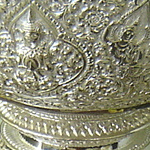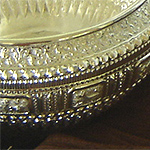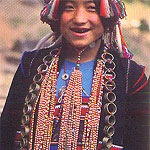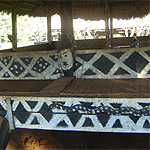Jewelry of South East Asia is hand made and remarkable for its beauty, technical complexity and sheer variety. Not only is it intricate in design and rich in symbolism but is sometimes seen as possessing enormous spiritual and protective powers. Jewelry, in this region, has also been used to communicate political power and wealth, social status, age and gender. Gold and silver articles apart from being decorative are a means of investing money and accumulating wealth.
Lao artisans are skilled at making belts, torques, necklaces, rings, bracelets as well as bowls and cups for ceremonial purposes.
HISTORY
Archaeological evidence indicates that gold and silver smithing was practiced from an early date in the areas of modern Laos that once formed part of the Khmer empire (9th-13th centuries). Evidence also depicts a picture of a society and court culture that was preoccupied with rank and in which jewelry was an important indicator of status.
In the 14th century, Fa Ngum, the first Theravada Buddhist king of Laos, brought jewelers and goldsmiths from Angkor to beautify his court at Luang Prabang. Royalty and court officials used jewelry to show hierarchy and rank through the display of their gold or silver ceremonial betel boxes, costumes and jewelry, decorations and precious stones on their weapons.
However, significant development of this craft did not take place until the first half of the 16th century, when skilled gold and silversmiths emerged at the royal court of Luang Prabang. During this period personal ornamentation, precious ritual objects and the Buddha image all showed outstanding development.

TRADITIONS AND MINORITY GROUPS
The best example of silverware and jewelry is the work of the hill tribes. Silver smithing is still practiced by a number of ethnic groups, predominantly by the Hmong, the Yao and Tibeto-Burman ethnicities such as the Akha and also by some Mon-Khmer groups in the southern part of the country
In many parts of the country the colourful costumes are decorated with profuse amounts of silver. Women wear torques, necklaces of gold, silver, ivory, bamboo and beads, bracelets, earrings and other ornaments.
Akha
The costumes of the Akha are distinct. Within each sub-group, caps and bonnets of various shapes and size are studded with coins and silver discs and plaques, and decorated with flowers, feathers and bright beads.
Silver ornaments are sewn onto garments in the form of small silver hemispheres, tiny discs and buttons, and large circular of rectangular plaques of shallow repousse work with floral and geometric designs. Akha women also wear flat beaten silver torques and bracelets engraved with floral designs.
Hmong
Among the Hmong, silver, rather than gold, is profusely used and associated with every aspect of their lives. Massive silver ornaments are worn by all and express prestige and beauty.
Silver is handed on to daughters by their mothers, as a part of their dowry. Among the Green Hmong, babies are dressed in their first silver torque before the umbilical cord is cut. Silver is twisted together with brass and iron in the special torques and worn in shamanistic healing ceremonies. Silver spangles are sewn on young women’s garments and chains of silver coins are attached to caps and jackets. At New Year, new jewelry is commissioned and old jewelry repaired and cleaned in preparation for the courtship games played by young men and women as part of the festivities.
Torques
Silver torques consisting of thick hollow tubes, with tapering ends, are be worn in sets of up to five in graduating sizes. The tips of Hmong torques are either curled into a pair of loops, or hammered flat into long triangles and turned back. Narrower solid silver torques may be twisted or hammered into spiral or prismatic forms.
Floral, geometric and leafy patterns are engraved on torques and pendants. These are sometimes enriched with coloured enamels of intense blue, green and yellow. The pendants serve a protective purpose.
Bracelets
Narrow open bracelets are engraved with shallow designs of flowers, buds and vegetal shoots. They are beaten flat and the open ends flare gently and are worn so as to display the ends.
Earrings
Hmong earrings include dangling silver spangle, silver circular rings beaten flat with curling split ends, earrings with dangling hooks with a rounded pyramidal button decorated with granulation. Some types of earrings worn by the Hmong are also worn and manufactured by the Yao.
Yao
The Yao are considered the finest metalworkers among the mountain dwellers. Their jewelry is worn by other groups like the Hmong.
A typical earring is formed like an arrow bent into a circle. Symbols and patterns like the rainbow dragon/naga, yin and yang, butterflies, birds and fish can be found on the ornaments.
Tai-Lao
The Tai Lao wear massive bracelets of twisted silver cords. As a part of the marriage customs, a woman must have a gold belt and the man must pay for his bride in gold.

PRODUCTS THEN AND NOW
Belts
Some Lao belts and buckles, richly embossed, are composed entirely of panels displaying the twelve animal symbols. In Laos they include the horse (Sunday) followed by the ox, the lion or ogre, tiger, buffalo, deer and elephant.
Less elaborate belts are fabricated from thick silver wire twisted into open grids of repetitive loops and spirals. Small lozenges, flowers or insects are soldered to the wires. Insect motifs may derive from traditional beliefs in which the soul takes the form of a firefly, ant or caterpillar.
Ear Ornaments
Heavy coiled ear ornaments with tapering tips still adorn the lobes of the minority people in Xekong provinces in southeastern Laos, as they have done in the past.
Ring
Rings are embellished with engraved floral motifs and gem stones.
Bracelets
Hollow silver bracelets are engraved and embossed with unusually free flowing vegetal motifs, bracelets of twisted hollow silver tubes and twisted solid silver cords, solid silver bracelets with lotus tips.
Daggers
Lao daggers from Luang Prabang have silver hilts; scabbards are embossed and engraved with a typically dense arrangement of vegetal ornamentation and flowers in lozenges and with the three headed elephant of Indra (the insignia of the royal family and the Lao state). Daggers of this type were employed in marriage ceremonies as symbols of protection.
Bowls
Silver bowls with ribbed or fluted exteriors are ubiquitous in Laos – both the regular silver bowls (oh tum) and the silver stem bowls (khan).

DESIGNS, MOTIFS AND SYMBOLS
The jewelry of Laos shows evidences of Tibetan, Chinese, and Indian stylistic influences. Many forms and motifs, such as the stylized lock and floral and vegetal decorations draw from Chinese decorative traditions. The designs and symbols have taken on new meanings apart from the original ones and often have double interpretations. There is rich symbolism inherent in traditional jewelry, for example, an item of jewelry may represent the universe in micro cosmic form and express complex human relations. The dragon/naga/snake motif is common and equated with the rainbow which links Mount meru, the abode of the gods, to the earth. The Naga is also considered to have tremendous protective powers.
PRACTITIONERS
Whole villages may specialize in a particular craft, such as making pottery or working with silver. Very fine work in gold and silver is often carried out in tiny places. In the past it was common for the client to provide the materials while the itinerant jewelers worked at the patron’s home under the watchful eye of a family member. Many small shops are run as family businesses. Some members manufacture jewelry, while others attend to customers and other affairs.
Jewelers continue to use traditional methods. The tools employed are extremely simple and often consist of a hammer, a few punches, some pincers and a bed of charcoal. Heat is intensified by blowing on the charcoal through a bamboo tube or bellow. Blow-torches attached to small portable gas cylinders are now increasingly employed for some operations. Large metal ornaments of solid silver or iron such as torques are often forged by the blacksmiths in the villages. These blacksmiths are considered masters of metal smithing, and skilled and versed in precise techniques.
RAW MATERIALS
Metals
It was customary in traditional communities to perform ceremonies and make offering to the spirits or deities who guarded the local deposits of metals and mines in the hope that the deposits will be revealed. Laos has a tradition of working in gold, silver, copper, bronze and other metals.
Horn and Shell
Ornaments made from horns or made in the form of horns and necklaces of glass beads and shells are worn by Austro-Asiatic- and Austronesian-speaking groups of Laos.
Silver And Enamel
While almost all minority groups wear torques, beaten and forged silver and coloured enamel are more commonly employed by the Tai and some Tibeto-Burmese-speaking peoples.
Beads
Some of the ethnic groups of the southern central highlands still favour small red and yellow beads. Faceted flat orange beads have been found in the Salavan and Xekong provinces in south-eastern Laos.
TECHNIQUES AND METHODS
Many techniques, forms and motifs employed are originally from India, China and the Islamic world – transmitted through trade, diplomatic and religious contact.
Anne Richter, in her book, of Southeast Asia, gives us details of both working and decorative techniques that are employed in the region.
Beating and forging
Solid ornaments such as torques and bracelets are often beaten or hammered into the required shape. Gold and silver, being soft, are beaten from ingots into sheet form and then stretched, curved and shaped. This, however, can often result in the metal cracking while being worked upon. By repeatedly heating and cooling the metal, this is avoided. Once shaped, the ornaments can be decorated using other techniques.
Die-stamping stone blocks
Designs are carved into blocks forming depressions in decorative shapes, and sheet metal is beaten from the back into the depressions to form ornaments. Often two halves of hollow gold and silver beads, for example, may be beaten into semi-spherical depressions and then soldered together.
Wire work
Wire is made from sheet metal cut into very thin strips. Wire is twisted, crimped or notched to create the appearance of fine beading and other decorative effects.
Thick wire is used to form spiral limb ornaments. Small tight circular springs of very fine wire may form small wire flowers or even secure a gemstone or a small metal ball. This technique is frequently employed in Laos, where broad necklace or bracelet bands may be covered with small wire flowers.
Chain-making
Chains are made using various techniques. One common technique is looping elliptical circlets of wire. Each circlet is first crimped into a figure of eight and then looped together into each other. The arrangement of loops may result in a circular or angular cross-section. If the links are looped sideways rather than longitudinally, a herringbone pattern is achieved.
DECORATIVE TECHNIQUES
The look of an item of jewelry is often enhanced using one or more decorative techniques. In South East Asian jewelry the following are commonly used:
Filigree: In the open filigree process, light brooches, pendants, bracelet clasps and beads are constructed from delicate wire deftly twisted into vegetal patterns.
Applied filigree: is very similar to open filigree. However, in this case the fine wire work is placed on a flat metal surface and either soldered or stuck onto the surface. The design worked is usually simple or complex vegetal-floral patterns.
Carving: Soft metals like gold and silver of high purity are carved using sharp tools.
Chasing: This technique chasing is used to refine the design on the front of the work by sinking from the front side. The metal creates the appearance of raised surface decoration by depressing the background. Indented patterns are made by cutting into or beating back some areas of the front surface. Chasing cannot produce very pronounced effects without destroying the integrity of the object, so it is often augmented using embossing or repoussage.
Embossing and Repoussage: IThe malleable metal is ornamented or shaped by hammering from the reverse side to form a raised design on the front.
Engraving: Shallow patterns are cut into a metal surface by a tool with a fine sharp tip
Granulation: Tiny metal granules or balls are applied to a plain surface, often in scrolls, rows and geometrical pattern such as triangles. The spherical forms are created by surface tension when tiny fragments of metal or wire are heated on a charcoal bed. When cool the balls are arranged and secured with resin adhesive. A very small quantity of solder is used and then, as for filigree work, the ornament is subjected to a very carefully applied burst of heat.
Open work: Sheet metal is pierced or punched to create holes of various shapes and sizes. An entire ornament such as a brooch or pendant may consist of leafy or lacy openwork.
Punching: Indented motifs, usually on a border, are achieved by gently hammering with a tool whose metal tip bears a pattern.
Gold and silver plating and gilding: Creating the effect of a gold or silver surface on an ornament of less valuable and usually more robust metal, including the application of leaf gold or gold sheet, which was glued to the ornament, then polished or burnished to create a smooth unified surface.
Setting gem stones: Stones are box-set rather than held in claws. The box is soldered on, and the rim was pressed gently inwards over the edge of the stone to secure it. Since most stones were of an irregular shape, the box was often made to follow their contours. In some items of the box was filled with resin and the precious stones were stuck into the resin before it hardened.
Colouring and staining
Silver: The pattern and texture of silver is sometimes enhanced by blackening or darkening the ornament with pastes made from plants or a sulphur preparation which reacts with the silver to create a black or brown colour. The surface is then polished, and contrasts with the dark colour remaining in depressions.
Gold: Gold alloys are sometimes given a red stain or transparent coating by repeated chemical cleaning, drying, very gentle heating, and submersion of the item in chemical compounds made from potassium nitrate or saltpeter, mixed with rock or sea salt and alum.
Gemstones
Gems are set to emphasize the beauty of the jewelry – they are valued according to their size, richness of colour and magical and healing properties attributed to them. Gem stones are worn for medicinal purposes were often set to give contact with the wearer’s skin. Traditionally gems are not faceted, but left in their natural shape and polished. Bokeo province is known for its sapphires and sapphire mining
PRICE
Jewelry is normally priced at the prevailing international price of pure gold or silver. To this are added the charges for workmanship. Gem stones are graded accorded to size, cut, colour and clarity, and are individually valued and priced.
CURRENT STATUS
Before 1975 Luang Prabang was known as a major centre for high-quality silverware. However, both gold and silver smithing declined after 1975 and has only recently begun to recover.
From the early years of the 20th century necklaces, bracelets, earrings and a range of distinctive small containers for the storage of betel and home made cosmetic preparations began to be produced to meet the demands of the growing urban population.
In recent years both the Lao Handicraft Association and the Design Centre Vientiane have offered short training courses in gold and silver smithing with a view to helping Lao crafts persons to develop new products and to upgrade the quality of existing goods.
Gallery
YOUR VIEWS
PRACTITIONERS: INDIA
Access 70,000+ practitioners in 2500+ crafts across India.
BIBLIOGRAPHY
10,000+ listings on arts, crafts, design, heritage, culture etc.
GLOSSARY
Rich and often unfamiliar vocabulary of crafts and textiles.
SHOP at India InCH
Needs to be written.






